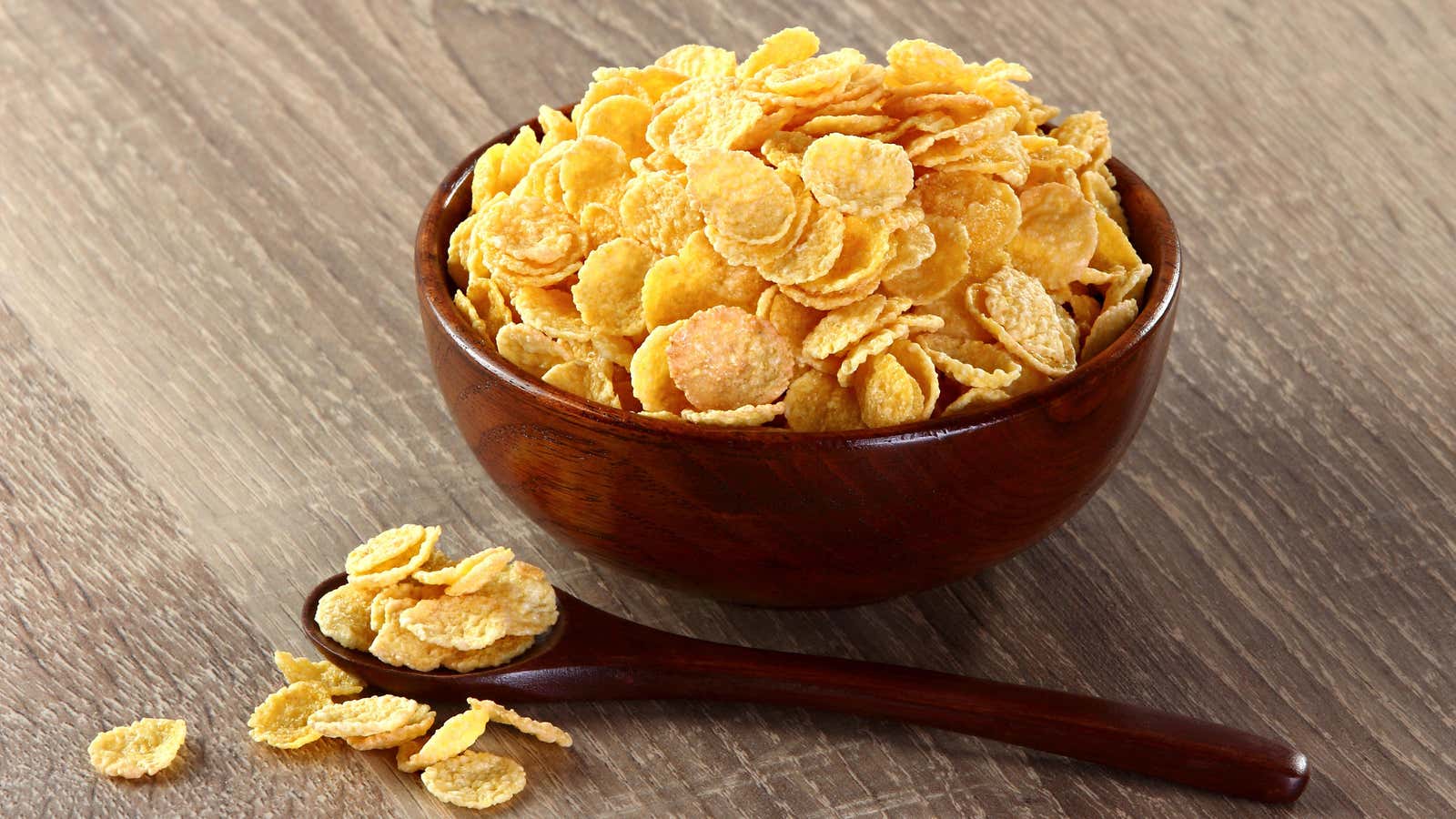What Is a “healthy” Cereal?

After the Food and Drug Administration changed the definition of “healthy” (for food labeling purposes), it turned out that many popular breakfast cereals did not meet these criteria. CNBC notes that Raisin Bran, Honey Nut Flakes, and Corn Flakes have too much added sugar to qualify. If you were surprised, buckle up, because the idea of making breakfast cereal “healthy” has a long and bizarre history.
Breakfast cereals were invented as a (very sketchy) healthy food.
Industrialized breakfast cereals have their origins in 19th-century health spas or sanitariums, and in the (frankly convoluted) theories of health and disease promoted by their founders.
John Harvey Kellogg is one name you might know; he ran the Battle Creek Sanitarium in Michigan. According to his teaching, unleavened food was the cornerstone of health; everything sweet, spicy or meaty was supposed to arouse passions and weaken the nervous system. Kellogg believed that frequent enemas were also necessary for health, that masturbation was so harmful that children should be prohibited from doing it by any means necessary , including mechanical devices and even surgery (he can be thanked for the popularity of non-religious circumcision), and was a great proponent of eugenics, right up to creating a “Race Improvement Fund” and writing books and articles on “racial degeneration”.
I don’t see anything particularly helpful in the above, but Kellogg was obsessed with these ideas that tasteless food, enemas, and NoFap are the key to good health. And these tasteless foods were the original source of breakfast cereal as we know it today. (Perhaps tortillas and crackers were so popular because yeast fermentation was considered too similar to the process of making alcoholic beverages ; these guys also avoided liquor.)
From the sanatoriums and the movements adjacent to the sanatoriums of that time, we get:
- Graham flour ( as in Graham crackers ) from Sylvester Graham, who also promoted a tasteless diet, vegetarianism, and as little sex as possible.
- Granola, originally sold as a granule , by James Caleb Jackson. It was in the form of baked grain gruel bricks that had to be soaked in milk or water until they were soft enough to be chewed.
- Cornflakes from Kelloggs, reportedly invented when a batch of the above went bad. John Harvey’s brother, Will Kellogg, founded a bulk cereal company. (Fun fact: it was Kellogg who changed the spelling of “granula” to “granola” after Jackson sued.)
- Grape Nuts sold by Charles Post, who stayed at the Kellogg Sanitarium and apparently liked the idea of breakfast cereal so much that he decided to sell his own.
- Shredded Ralston, the forerunner of Wheat Chex, from a guy who was also into eugenics and was obsessed with preventing life forces from leaving the body; it gets weirder .
To be honest, now I’m afraid to google any other cereal brands.
Sugar was added to porridge almost immediately
Who wants a tasteless porridge for breakfast? Almost no one, it turns out. One of the first things Will Kellogg did when he started selling corn flakes was adding malt, sugar, and salt . Graham flour products were originally unsweetened – not at all like the cookie-like graham crackers we have today.
It didn’t take long for cereal owners to realize that they could sell more of their product if it really tasted good. According to this timeline from the New York Times , sugary cereal did become popular around the 1950s. The corn flakes were not sweet enough; we also needed frozen cereal.
The escalation continued in the 1970s. Popular children’s cereal was filled with sugar, cocoa and food coloring in different shades. (Of course, you could still buy Grape Nuts from the shelf right above them.) As a kid in the 1980s, I remember being told I couldn’t eat rainbow-colored Rainbow Brite cereal because my mom was in shock. from them. have “so much dye”. I’ve read cartoons by Calvin and Hobbes in which the main character chews on fictional chocolate glazed sugar bombs.
Granola returned to the scene in the 1970s as part of the backlash against sugared commercial cereals. The sweet cereal has also tried to cultivate its healthy image: Sugar Pops became Sugar Corn Pops in 1978 and Corn Pops in 1984. Cereals with added vitamins trumpeted it on the label. (The history of fortifying cereals with vitamins is long . Sometimes vitamins were added to make cereals seem healthier, sometimes supplements were required by law.)
What are “healthy” cereals made of today?
This brings us back to the present. Cereals like corn flakes and raisin bran may seem healthier than their relatives, frosted flakes and fruit loops, but they are still in the category of sweet, tasty foods to eat in the morning. They say that American breakfasts are mostly desserts , and that seems to be about right (i.e. outside of the bacon and egg food group).
So, are corn flakes and the like “healthy”? I mean, the whole concept revolts me , but I certainly wouldn’t be looking for healthy food in the cereal section if you asked me where to start. However, they are not bad : some have fiber, and most have added vitamins and minerals. We serve them with milk, which contains at least a little protein, vitamins and other useful substances.
I think the more important question is whether we have reason to believe that grains are good for health. The idea that a particular breakfast meal gives a good start to our day off is now over a hundred years old and has never had a solid scientific basis to begin with. Eating cereal for breakfast is a lot like eating muffins: they’re delicious and commonplace, but the nutritional label doesn’t quite live up to many of the health claims.